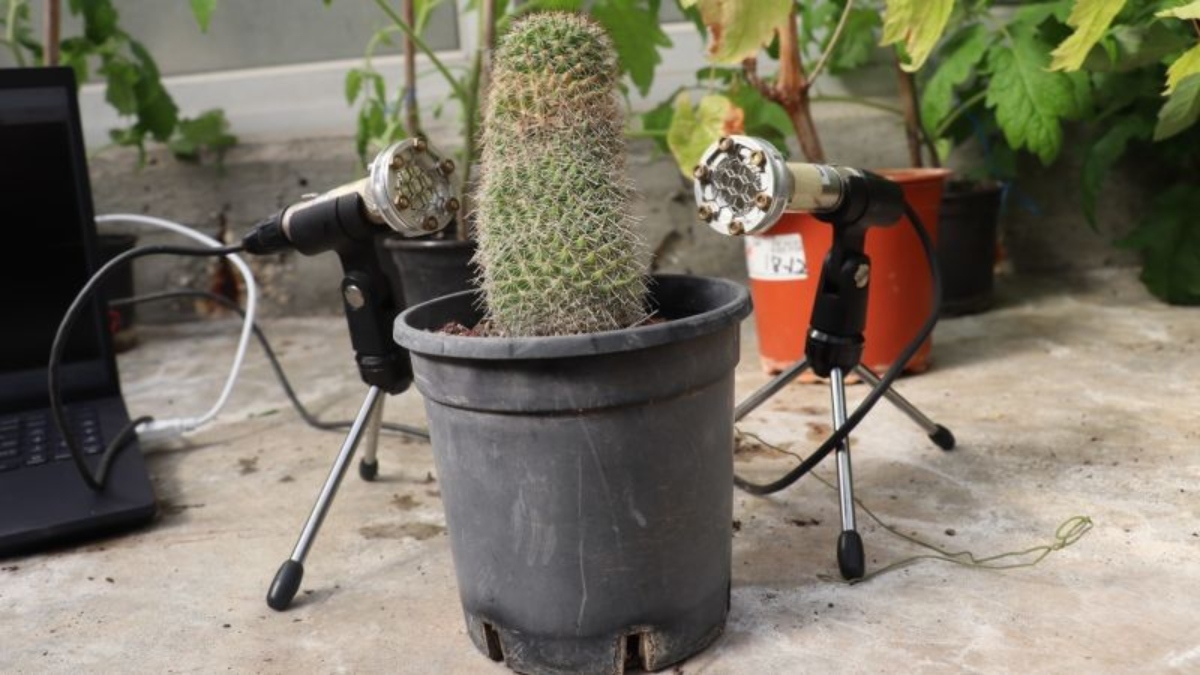(CNN) — According to recordings made in a, plants produce sounds that cannot be detected by the human ear A new studyThey become louder under dehydration or other forms of stress.
The research seriously calls into question what most botanists thought they knew about the largely silent plant kingdom. It also suggests that the world around us is a cacophony of plant sounds, said Lilach Hadani, co-author of the study.
Hadani said he had long suspected that plants were completely silent.
Professor in the School of Plant Science and Food Safety and George S. “There are many organisms that respond to sound,” said Hadani, director of the Vice Professor of Life Sciences at Tel Aviv University.
The first plant Hadani recorded using an ultrasonic microphone was a cactus in his lab six years ago, but he couldn’t rule out that the sound he detected was produced by something else in the environment. Previous studies have shown that plants produce vibrations, but it is not known whether these vibrations are converted into sound waves in the air.
To determine whether plants actually make sounds, Hadani and his team deployed soundproof speakers.
The researchers placed tobacco and tomato plants in boxes equipped with ultrasonic microphones that recorded frequencies between 20 and 250 kHz. (The highest frequency detectable by an elderly human ear is about 16 kHz.) Some plants had their stems cut or hadn’t been watered for five days, while others were untouched.
The team found that the plants made sounds in the 40 to 80 kHz range that, when condensed and morphed into a frequency that humans can hear, sounded a bit like popping popcorn or popping plastic bubbles.
Listen to the sound of the tomato plant
These are the sounds a dry tomato plant makes within an hour. Audio was sped up and moved into the range of human hearing.
Source: Kite et al.
A stressed plant made 30 to 50 clicks per hour at random intervals, but unstressed plants made very few clicks per hour.
“When tomatoes are not stressed, they are very calm,” Hadani said.
The team conducted the experiments in a greenhouse and placed the plants in soundproof boxes. (Courtesy of Tel Aviv University)
Do plants communicate? Not so fast
Researchers aren’t exactly sure how the sounds are made, but they believe they come from cavitation, a process in which an air bubble in a plant’s water column collapses under some kind of pressure, making a click or pop.
But rest assured, a bouquet of cut flowers in your vase isn’t making you scream in pain. There is no evidence that the noise the plants make is intentional or a form of communication.
“This result adds to what we know about plant responses to stress. It is a useful contribution to the field and to our general appreciation that plants are sensitive organisms with sophisticated behaviors,” said Richard Carbone, professor of entomology at the University of California, Davis. hostesses. He was not involved in the investigation.
“However, this should not be interpreted as showing that plants actively communicate using sounds,” Carbon added.
Although plant sounds are a passive phenomenon, other organisms can use the plant’s audible signals to their advantage, said sensory ecologist Daniel Robert, professor of biological sciences at the University of Bristol, United Kingdom. The academic is not involved in the research.
For example, he said, sounds can convey the message to a female moth that a particular tomato plant is stressed and unsuitable for laying eggs or feeding.
“Many sounds are produced in the world that are not ‘intentional’ signals, but are nevertheless heard and used by other organisms for their own benefit. So the concept of communication is a challenge… Does it have to be two-way to work and be perceived as such?” he said via email.
Lead authors of the study are Yossi Yovel, left, and Lilac Hatani. Both are professors at Tel Aviv University. (Courtesy of Tel Aviv University)
Who is listening?
The team repeated the experiment with tobacco and tomato plants in a noisy greenhouse environment. After recording the plants, the researchers developed a machine learning algorithm that could distinguish between unstressed plants, thirsty plants, and cut plants.
“It’s exciting to use neural network classification to find information in sound emissions, as such (a) technique is fast and can identify data structures that cannot be detected by the human eye or ear,” noted Robert.
Because tobacco and tomato plants are easy to grow in a standardized manner, the researchers also recorded the sounds of different types of plants, including wheat, corn, cactus and grapes, and made them. Louder sounds when they are stressed.
Besides insects or mammals that can detect and use plant sounds, other plants can also benefit from hearing sounds, Hatani said. Previous work by Hadani and other team members has shown that plants increase the sugar concentration in their honey when they “hear” pollinator sounds.
Hatani said he saw plants and flowers differently now. “There are a lot of songs we haven’t heard.”



:quality(85)/cloudfront-us-east-1.images.arcpublishing.com/infobae/DYRQWUXU2VHMHNIVOD22JCU2KU.jpg)
:quality(85)/cloudfront-us-east-1.images.arcpublishing.com/infobae/HVMMKV4KMVDNVJD5W5F7GK4AHY.jpg)
